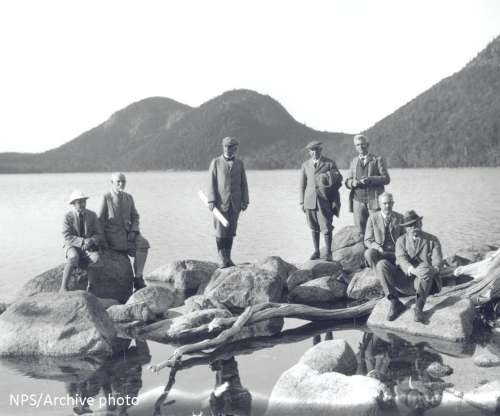


I feel like I should start this post with a disclaimer: Acadia National Park, on Maine’s Mount Desert Island, is one of my all-time favorite places, ever. Which explains why I was so excited when Ronald Epp (who recently finished the first book-length biography of park founder George Bucknam Dorr) contacted me to find out if the TR Site would be interested in having him speak about this unsung hero of the American environmental movement and the pioneering role he played in the development of a unique conservation model. Needless to say, when Dr. Epp arrived last month and began weaving a complex story of philanthropy and environmental conservation, aided and inspired by Harvard connections, I was fascinated.
Dr. Epp began his remarks by pointing out that September 14th, 1901 was an important day for the environmental conservation movement on at least two levels. That was the day that Theodore Roosevelt -- the first and arguably the most enthusiastic president to put conservation on the national agenda -- took the oath of office. On the same day, a small group of men met on Maine’s Mount Desert Island and took the first steps in the lengthy process that ultimately led to the creation of Acadia National Park.
It should probably be noted that Maine and Mount Desert Island were both familiar to the new president. While he was an undergraduate at Harvard, TR spent time in Maine -- an interlude that some scholars suggest was critical to his appreciation of the natural world and his evolution as a conservationist. After graduation in 1880, Roosevelt returned to Maine and spent time on Mount Desert Island. TR hiked Mount Desert’s mountains, sailed its waters, and rode horseback on its trails. The oceanside setting also provided inspiration as he worked on his first book, The Naval War of 1812.
The men who met on Mount Desert Island twenty years later, as Roosevelt was being inaugurated in Buffalo, were brought together by Charles W. Eliot. Perhaps best-known for his role as president of Harvard, Eliot’s family had long-standing connections to Mount Desert Island and his oldest son was a pioneering landscape architect. In the last years of the nineteenth century, Eliot watched with concern as development began interfering with Mount Desert Island’s landscapes and public access to that land was being restricted by new owners. Thus, Eliot arranged a series of late summer meetings in 1901 that led to the formation of a land trust known as the Hancock County Trustees of Public Reservations (HCTPR). The handful of men who formed HCTPR sought “to acquire, by gift or purchase, land deemed important for its scenic or historic value – and then manage it for public use.”
Working closely with Eliot and serving as HCTPR’s first Vice President was George Bucknam Dorr, another “Harvard man” whose familial connection to Mount Desert Island began in 1868. Dorr gave life to HCTPR’s ambitious goals. In fact, it was largely due to Dorr’s determination and energy that HCPTR was able to acquire the 5,000 acres that became the nucleus of what is now Acadia National Park. Dorr not only worked with landowners to encourage donations, but also later cultivated a crucial relationship with John D. Rockefeller, Jr.
Despite HCTPR’s successes, Dorr and Eliot were concerned -- due to the political climate in the state -- that the land trust would ultimately be unable to protect the lands it had acquired. Because federal protections would be stronger, a plan was hatched to offer the amassed property to the federal government. Dr. Epp explained that this idea was entirely new and considered somewhat suspect at first. In the past, national parks and monuments (think Yosemite or Devil’s Tower) were carved out of land that was already owned by the federal government. When HCTPR approached the Department of Interior with their proposal, lawmakers and others had a hard time understanding why anyone would want to give anything to the federal government. George Dorr took on the daunting task of going to Washington and lobbying for the unorthodox proposal. Thanks largely to Dorr’s persistence, Woodrow Wilson declared the donated land a national monument on July 8th, 1916 (a mere seven weeks before the National Park Service was formally established). Not quite three years later, it was elevated to national park status and became the first national park east of the Mississippi River. George Dorr served as the park's first superintendent and continued to shape its course for the next quarter-century.
Dr. Epp concluded his remarks by reflecting on the conservation ethic -- created and promoted by the likes of George B. Dorr, Charles Eliot, and John D. Rockefeller, Jr. -- that ultimately allowed for the creation of Acadia National Park. In addressing a unique set of circumstances, these men drew upon their distinctly New England roots and incorporated values such as: self-determination; innovation; a reliance on individual leadership; a strong investment in place; civic engagement; and, perhaps most important, an ethical concern for the environment and future generations.
-- Lenora M. Henson, Curator / Director Public Programming
*****
Speaker Nite is part of the TR Site’s regular Tuesday evening programming, which is made possible with support from M&T Bank.

The Theodore Roosevelt Inaugural National Historic Site is operated by the Theodore Roosevelt Inaugural Site Foundation, a registered non-profit organization, through a cooperative agreement with the National Park Service.
© 2025 | All Rights Reserved
641 Delaware Avenue, Buffalo, NY 14202 • (716) 884-0095
Website by Luminus
